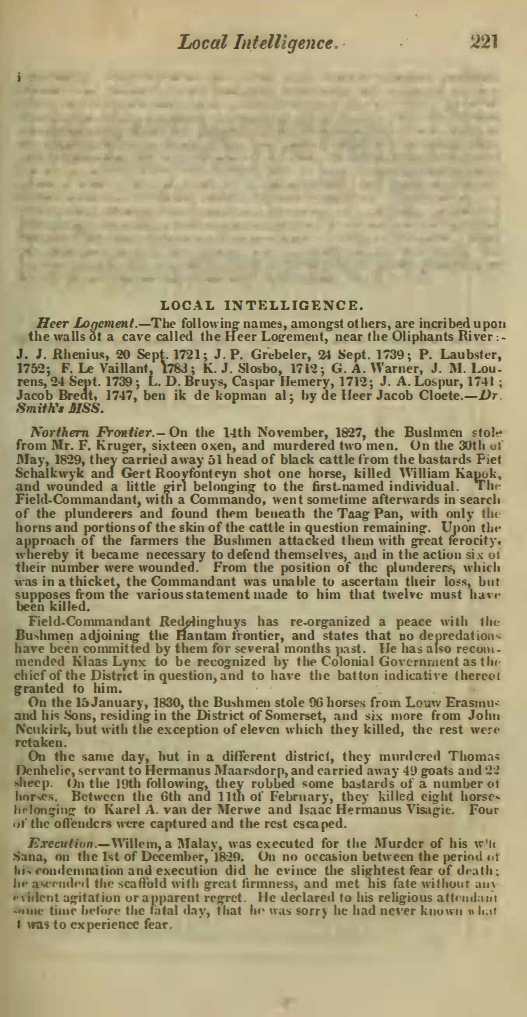Local intelligence
DOI:
https://doi.org/10.21504/saqj.12.2641Keywords:
Cape of Good Hope, Heer Logement Cave, Colonial inscriptions, Frontier conflict, Bushmen (San), Field Commandant Redelinghuys, Klaas Lynx, Crime & Punishment, Cape Colony, Willem the Malay, Colonial trade, Cape Colony -- population statistics, Slavery, Cape census, Wine exports, Early South African history, 18th–19th century colonial administrationAbstract
This compilation of local intelligence from the Cape of Good Hope provides a valuable record of early colonial inscriptions, frontier conflicts, executions, trade statistics, and demographic returns from the eighteenth and early nineteenth centuries. The report opens with an account of the Heer Logement Cave near the Olifants River, whose walls bear historic inscriptions dating from 1721 to 1783, including signatures of travellers such as J. Rhenius, F. Le Vaillant, and Jacob Cloete, serving as early evidence of European exploration in the Cape interior.
Subsequent reports from the Northern Frontier (1827–1830) detail violent encounters between colonial settlers and Bushman (San) groups, including livestock raids, retaliatory expeditions, and the eventual negotiation of local peace under Field Commandant Redelinghuys, who recommended formal recognition of Klaas Lynx as chief in the Bantam frontier district. The section also records the execution of Willem, a Malay, for the murder of his wife in December 1829, described in detail for its unusual composure at death.
Extensive statistical data follows, documenting imports and exports between 1807 and 1829 (expressed in rix-dollars), showing steady commercial expansion through the 1810s and 1820s, particularly in colonial produce such as wine, aloes, hides, ivory, and gum. A detailed population return (1806–1829) traces demographic shifts across Christians, Free Hottentots, and enslaved populations, illustrating both gradual population growth and early social stratification. The 1829 district census enumerates free and enslaved inhabitants across Cape Town, Stellenbosch, Worcester, Swellendam, George, Uitenhage, Albany, Somerset, and Graaff-Reinet, totalling 118,544 persons with corresponding records of births and deaths.
Collectively, these reports provide a rare composite view of the colonial Cape’s social, economic, and geographic evolution, combining ethnographic observations, military dispatches, trade analyses, and civic record-keeping. They serve as an essential source for reconstructing patterns of frontier conflict, labour, demography, and commerce in early nineteenth-century South Africa.
Downloads

